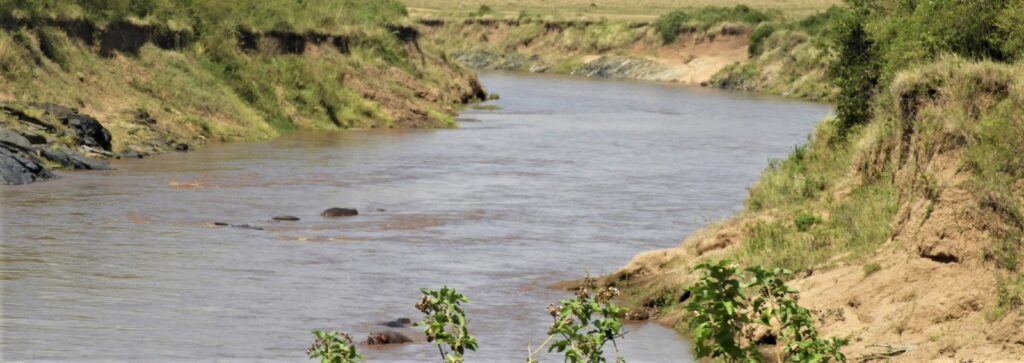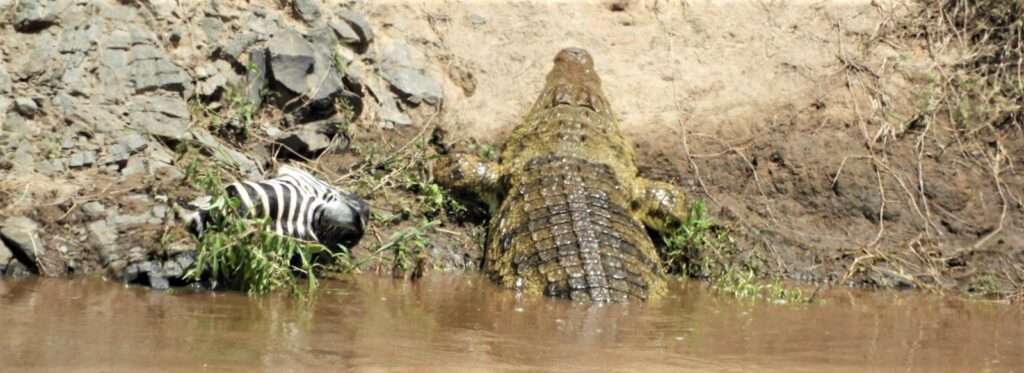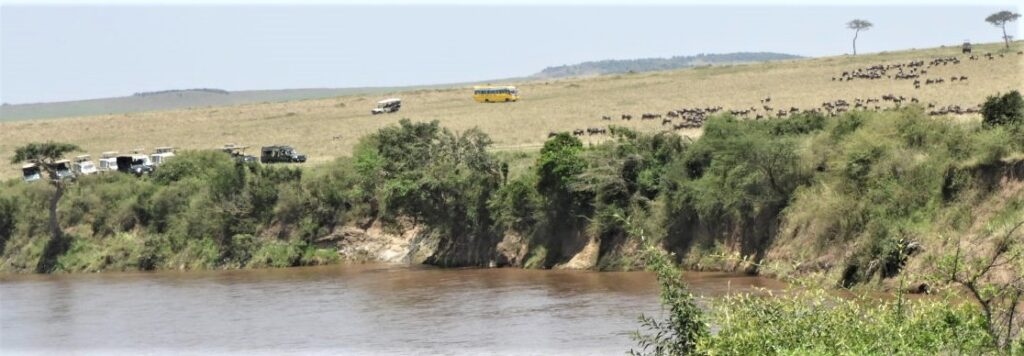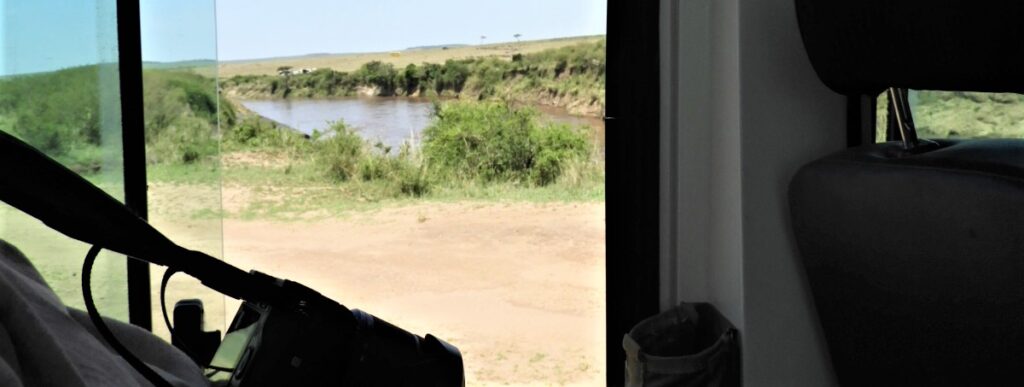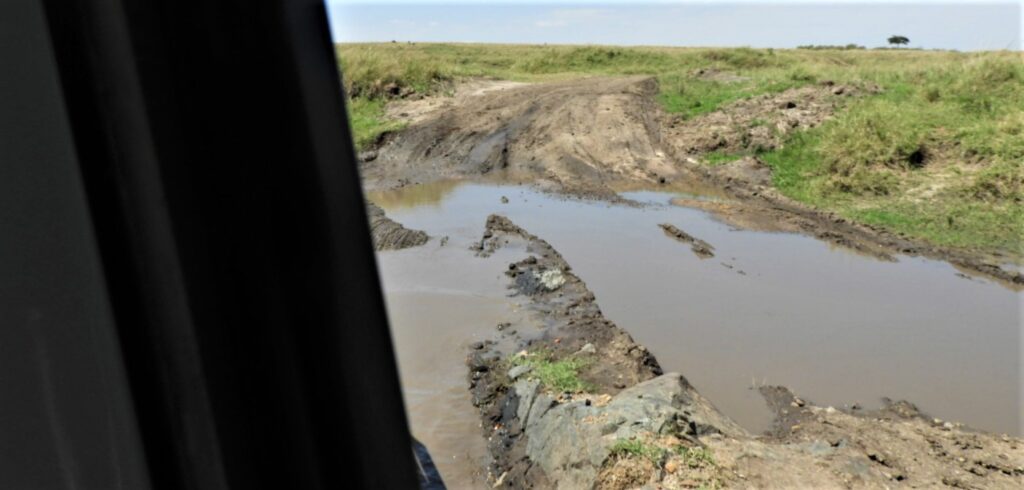» posted on Friday, September 16th, 2022 by Linda Lou Burton
Crossing The Mara
Linda Lou Burton posting from Sarova Mara Game Camp, Maasai Mara National Reserve, Kenya– The Great Migration, ah, that rousing event that sometimes results in more blood  and gore than even the Coen Brothers could think up. Or, it could wind up as cozy as a Sunday morning sleep-in, as we witnessed. We did see a crocodile-in-waiting, and a line of wildebeests stretching as far over the horizon as the eye can see. This photo I grabbed off the net shows what could, and often DOES, happen when a wildebeest tries to cross the Mara River, as below.
and gore than even the Coen Brothers could think up. Or, it could wind up as cozy as a Sunday morning sleep-in, as we witnessed. We did see a crocodile-in-waiting, and a line of wildebeests stretching as far over the horizon as the eye can see. This photo I grabbed off the net shows what could, and often DOES, happen when a wildebeest tries to cross the Mara River, as below.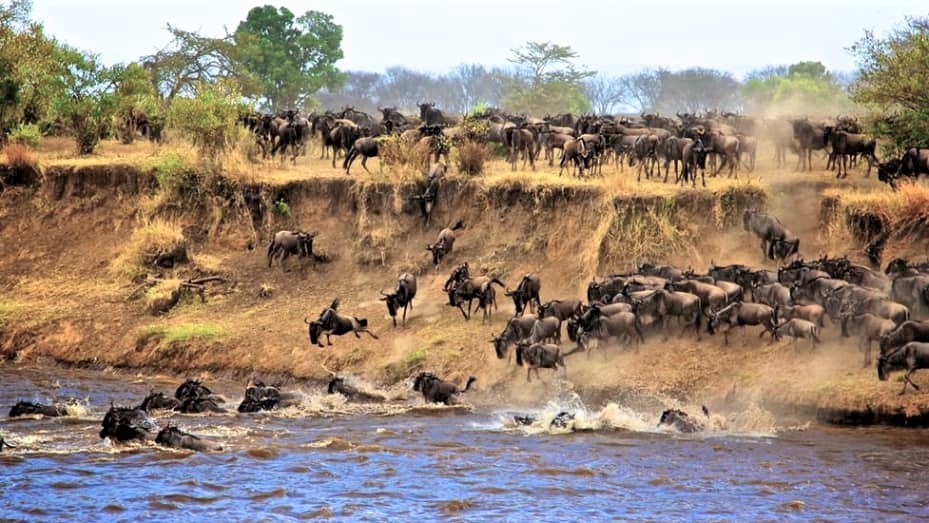
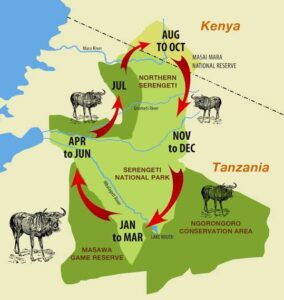 Why cross the Mara River? It begins with the weather. The weather creates rainy seasons and dry seasons. The rainy seasons are when the grasses grow. Over a million wildebeest eat a lot of grass. So do half a million zebras, and half a million eland and gazelles. When the grass is gone in one place, they move to a greener pasture. All this occurs in a regular pattern over a year’s time, as the grazers move in a clockwise direction from Tanzania’s Serengeti National Park across the border to the north to Kenya’s Maasai Mara and then back south again. As you can see on this map, they have to cross the Mara River twice to do that! And thousands of Nile crocodiles live in that river, just waiting for lunch to arrive. Which means people line up along the riverbanks to see what might happen. Will the wildebeests cross today while we’re here? What are they waiting for? Is there a leader, giving a signal? What causes the first one to start running, and what causes the others to follow in a spectacular frenzy of rolling and tumbling and jumping and swimming?
Why cross the Mara River? It begins with the weather. The weather creates rainy seasons and dry seasons. The rainy seasons are when the grasses grow. Over a million wildebeest eat a lot of grass. So do half a million zebras, and half a million eland and gazelles. When the grass is gone in one place, they move to a greener pasture. All this occurs in a regular pattern over a year’s time, as the grazers move in a clockwise direction from Tanzania’s Serengeti National Park across the border to the north to Kenya’s Maasai Mara and then back south again. As you can see on this map, they have to cross the Mara River twice to do that! And thousands of Nile crocodiles live in that river, just waiting for lunch to arrive. Which means people line up along the riverbanks to see what might happen. Will the wildebeests cross today while we’re here? What are they waiting for? Is there a leader, giving a signal? What causes the first one to start running, and what causes the others to follow in a spectacular frenzy of rolling and tumbling and jumping and swimming?
All a mystery, but Daniel did his part so we could see everything there was to see; shifting our 4×4 this way and that, around the 30 or so others waiting on our side of the river; all jockeying for position. And which WAS the best position? There were several possible crossing points. The other side of the river was lined with 4x4s too, and school buses, yes, this is a school-trip-worthy event. The zebras graze nervously as we wait; the giraffe stand high, peering, maybe counting the numbers of wildebeests in the line? Otis spotted a crocodile waiting on the riverbank. “It’s THERE!” he said, over and over, “by the zebra’s head!” My camera zoom finally caught it. Yep, zebra head by crocodile head. We waited. And we waited. And we waited. The hippos weren’t afraid, swimming the Mara with little hippo eyes just at the surface; stretching out on the bank in a muddle of hippo fat. And smiling, I swear!
We didn’t pack a lunch, so Abdi finally called TIME. He had an obligation to keep us fed, and it was a long drive back to Sarova’s dining room. “Sorry, we have to leave,” he said. Aww, shucks. Daniel made sure we had our own “crossing” thrill however, bless his heart. “Hold on!” he yelled, as he 4×4’ed us across a Mara mudhole. Then we passed a group of wildebeests that had already made it across, grazing in their greener pastures. A good morning, all told.
Note: During the migration about 250,000 wildebeest and 30,000 zebra die every year as a result of predation by carnivores, drowning, thirst, hunger, and exhaustion. An average of 6,250 animals drown or are trampled crossing the Mara River.
A Brighter Note: As many as 500,000 wildebeest are born between February and March each year as the rainy season begins. Approximately 8,000 young wildebeest are born every single day during the peak of the birthing season.


